Unveiling the Mystique of Green Rubies and Their Significance
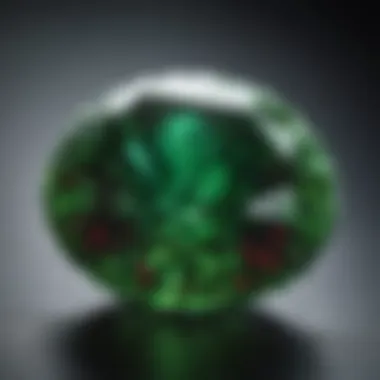
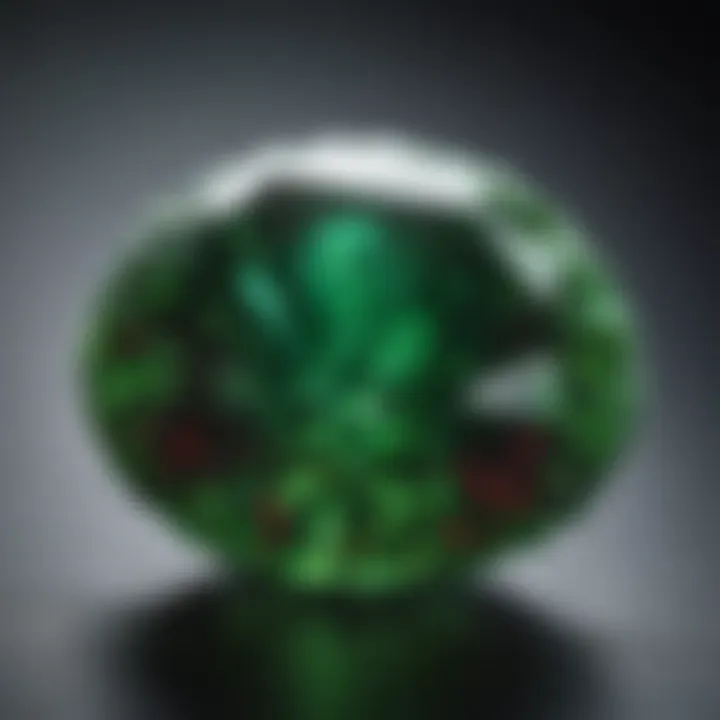
Intro
Green rubies are a fascinating variant of corundum that have sparked the interest and curiosity of gem enthusiasts, collectors, and jewelers alike. While red rubies are widely known and cherished, the green variety is particularly rare, leading to unique characteristics and significance in both gemology and cultural contexts. This article delves deeply into this remarkable gemstone.
Gemstone Overview
Definition and Origins
Green rubies are not independent mineral species but rather a specific hue of corundum. Corundum is an aluminum oxide mineral, and its color variations arise due to trace elements during formation. The green hue typically results from the presence of chromium. Their origins can be traced to metamorphic rocks, where intense heat and pressure facilitate the formation of these stunning gemstones.
Traditionay, these stones have been unearthed in regions known for their geological activity, such as Myanmar, Thailand, and parts of Africa. Their exceptional rarity often elevates them to a status reserved for elite gemstones.
Historical Significance
Historically, gemstones have been linked with power, status, and beliefs. Green rubies, although less prominent than their red counterparts in ancient societies, have held a meaningful place in various cultures. In some traditions, green stones symbolized growth, renewal, and prosperity. Collectors often admire them not just for their beauty but also for their connection to ancient lore.
"The allure of green rubies lies in their hidden depth and history, drawing collectors to their unique qualities."
Gemstone Properties
Hardness and Durability
One of the defining features of green rubies, like other corundum gemstones, is their remarkable hardness. They rank 9 on the Mohs scale, making them highly durable and resistant to scratches and abrasions. This property positions them as suitable candidates for diverse jewelry applications, especially in rings that undergo frequent wear. In terms of maintenance, regular gentle cleaning with mild soap and water is recommended to maintain their brilliance.
Color and Clarity
The color of green rubies can range from pale green to deep, vivid green. However, the most sought-after stones exhibit a rich, intense hue that captures light beautifully. Clarity is equally important in determining value; inclusions can diminish the stone's beauty and worth. Collectors often seek out stones with minimal inclusions and superior color saturation.
To summarize, green rubies embody a fascinating blend of rarity, historical significance, and impressive properties. These aspects make them a compelling topic for study and appreciation among gemstone enthusiasts.
Preamble to Green Rubies
The topic of green rubies is both fascinating and relevant within the world of gemstones. This section lays foundational insights for understanding what makes green rubies distinct and valuable. As gemstone enthusiasts, collectors, and jewelry designers explore their options, grasping the nuances of these unique stones becomes paramount. The beauty, rarity, and intriguing formation of green rubies contribute significantly to their allure.
Understanding green rubies requires a multifaceted approach. It is important to consider their definition, history, and the geological processes that lead to their creation. Moreover, the cultural significance and market demand provide layers of context that enhance their appeal.
Definition and Overview
Green rubies are a rarer variety of rubies, characterized by their striking green color. This hue arises primarily from the presence of chromium, much like their more familiar red counterparts. These gemstones fall under the corundum species, which encompasses a variety of colors, each determined by the trace elements present during their formation. The term "ruby" traditionally refers to red corundum, but the classification of green rubies presents a unique challenge for gemologists and collectors alike.
The true definition of green rubies often leads to discussions around nomenclature. While some refer to them as green sapphires due to the standards set within the gemstone trade, others argue for recognition as distinct items. This debate continues to shape how these stones are marketed and perceived in various cultures and marketplaces.
Historical Context and Significance
The journey of green rubies through history reveals their significance across various civilizations. Ancient cultures have long revered gemstones not only for their beauty but also for their believed properties. For instance, in Asia, green gemstones were often associated with life, prosperity, and protection.
In recent periods, the perception of green rubies has evolved. Initially overshadowed by red rubies, these green gemstones are now recognized for their uniqueness. Their rarity enhances their desirability among collectors. Artisans and designers have gradually started incorporating them into contemporary jewelry, which has elevated their status further.
"Green rubies possess a unique charm that embodies both rarity and historical significance, bridging ancient beliefs and modern aesthetics."
Formation of Green Rubies
The topic of the formation of green rubies is essential to understanding their unique qualities and value in the gemstone market. Knowing how these gems are created can lead to better appreciation and informed acquisition. Green rubies, although rare, are compelling due to their distinct geological origins. This section will explore the specific geological conditions that contribute to their formation, as well as their mineral composition, both of which play a crucial role in their aesthetic and physical properties.
Geological Conditions Required
Green rubies form under high temperature and pressure, conditions often found deep within the Earth's crust. For the formation of these gemstones, specific factors must align. High-grade metamorphic rocks, such as gneiss and schist, provide the necessary environment. The rocks must also be rich in aluminum and chromium, which are the primary minerals involved in ruby formation.
"The presence of chromium gives rubies their characteristic red to green hues, depending on other elements in play."
Typically, green rubies emerge when specific geological activities occur, such as:
- Volcanic Activity: Sometimes, volcanic eruptions introduce new minerals to the existing substrate, which may change the ruby's color.
- Metamorphism: The transformation of existing rocks under heat and pressure can alter the mineral makeup, further by changing its color.
- Elemental Influences: The presence of iron alongside chromium can result in green shades, creating the distinction between standard rubies and green rubies.
These geological processes define where green rubies can be found and subsequently influence their rarity. Each crystal’s growth location can lead to an entirely different appearance and value, making the study of their formation vital for collectors and gem enthusiasts.
Mineral Composition
Understanding the mineral composition of green rubies is key to appreciating their beauty. Essentially, a ruby is a variety of corundum, a crystalline form of aluminum oxide. The unique green color originates from the combination of specific trace elements mixed with the corundum framework.
Green rubies are primarily composed of:
- Aluminum Oxide (Al2O3): This is the foundational structure.
- Chromium (Cr): This element is mainly responsible for the vibrant colors found in rubies.
- Iron (Fe): Iron also contributes to green shades and can alter the overall hue.
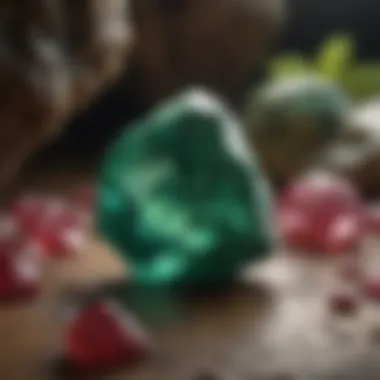
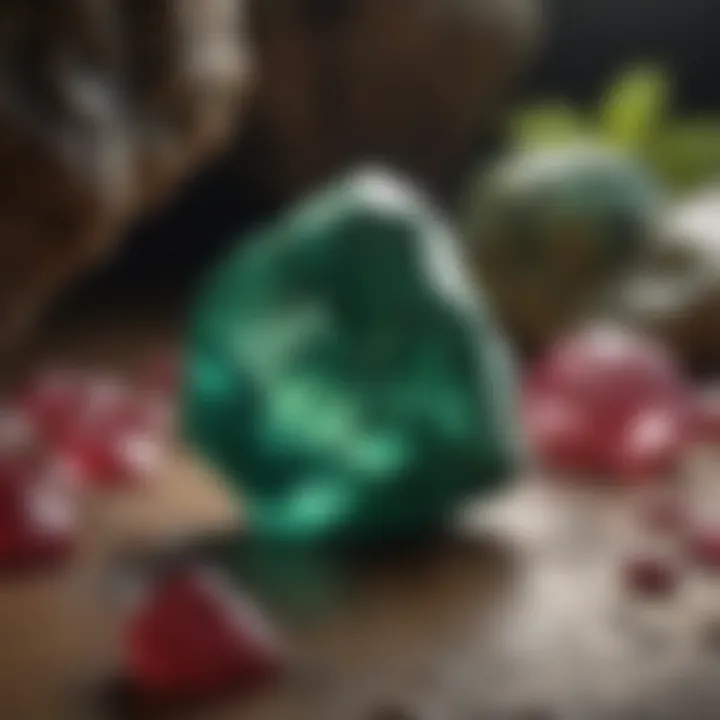
The presence of these minerals can significantly impact the stone's appearance, even on a microscopic level. For example, variations in iron concentration can lead to subtle color differences, emphasizing the complexity behind each gem. Collectors should be aware that these mineral elements not only affect visual aspects but also the stone's durability and clarity.
Rarity and Availability
Understanding the rarity and availability of green rubies is vital for gemstone enthusiasts and collectors alike. Green rubies offer a unique value in the jewelry market due to their limited availability. Although traditionally red rubies are more widely recognized, green rubies have their own distinct allure. Knowing where to find them and how the market dynamics affect their value is essential for informed buying decisions.
Sources of Green Rubies
Green rubies are predominantly found in specific geographical regions, which makes their sourcing a critical aspect of their rarity. The primary sources include countries like Myanmar and Thailand. However, other regions such as Tanzania and Sri Lanka also contribute to the global supply. Each of these locations has its unique geological conditions, impacting not only the color but also the overall quality of the stones.
Mining conditions can vary significantly. In Myanmar, the traditional mining methods involve artisanal techniques, which can yield stones of exceptional quality but with lower overall quantities produced. On the other hand, mining operations in Tanzania may employ more modern methods but face environmental challenges. The variation in sourcing directly relates to supply constraints, making green rubies an investment that can appreciate over time due to their scarcity in the market.
Market Demand and Supply
The demand for green rubies has been steadily growing. As consumers become more knowledgeable about gemstones, the appreciation for green rubies has increased. This growth in interest is often tied to fashion trends and the rise of unique gemstone jewelry that stands apart from traditional diamond or red ruby pieces.
However, the supply does not always keep pace with the rising demand. Buyers should be cautious as this imbalance may lead to price fluctuations. Factors that influence market demand include:
- Fashion Trends: As designers incorporate green rubies into their collections, the desire for these stones rises.
- Cultural Significance: Regions with strong cultural ties to green rubies can drive local markets, further increasing demand.
- Investment Potential: Collectors consider green rubies as gemstones that may yield high returns due to their rarity, leading to increased sales in the market.
In summary, while green rubies can be a delightful addition to any collection or jewelry piece, their rarity and the complexities of supply and demand warrant careful consideration for potential buyers.
"Investing in green rubies is not just about beauty; it’s about understanding their place in the market and the factors that influence their value."
The current landscape of green rubies showcases how rarity impacts their desirability, making informed decisions regarding sourcing and market trends crucial for collectors and investors.
Physical and Optical Properties
The physical and optical properties of green rubies are paramount to understanding their value and allure. This section explores how these properties influence not only the aesthetic appeal of the gemstone but also its desirability in both the gem market and among collectors. Green rubies exhibit a unique beauty, making them stand out among other gemstones. Understanding these properties can aid buyers and collectors in making informed decisions.
Color Variations
Color is perhaps the most defining characteristic of green rubies. It ranges from light green to deep, dark shades. The specific hue often results from the presence of chromium and iron in varying amounts. For instance, higher levels of chromium can create a richer, more vibrant green, which is generally more sought after in the market.
Green rubies can also exhibit secondary colors, such as yellow or brown, which can affect their overall appearance. Collectors appreciate pure, vivid green stones, so any noticeable hues can influence a stone’s value.
The placement of these stones can also affect their perceived color. Under different lighting conditions, a green ruby might appear to take on different shades. For example, in natural daylight, the color can seem more vivid, while in artificial light, it may appear darker. This variability emphasizes the importance of viewing gemstones under various lighting conditions before investment.
"The color of a gemstone is often the first aspect noticed by potential buyers and can significantly influence purchasing decisions."
Transparency and Clarity
Transparency and clarity are essential factors in assessing the quality of green rubies. These stones are typically evaluated for how well light can pass through them. The best examples tend to be transparent, allowing light to reflect beautifully within the stone. A highly transparent green ruby can exhibit vibrant colors and a captivating brilliance, making it more desirable.
Clarity is another crucial aspect. Natural inclusions are common in gemstones, but they can detract from a stone's aesthetic appeal. In green rubies, the presence and nature of inclusions can impact value. Stones with fewer and less visible inclusions are generally considered of higher quality. However, some collectors appreciate the character that certain inclusions can provide.
It is worthwhile for collectors and buyers to realize that each stone has unique attributes that tell a story. Careful examination of color and clarity is essential when evaluating potential purchases to ensure that the selections made are both beautiful and valuable.
Cultural and Symbolic Significance
The importance of cultural and symbolic significance in the context of green rubies cannot be overstated. These gemstones carry deep meanings across different cultures and societies. From ancient myths to modern beliefs, green rubies evoke emotional and intellectual reactions that enhance their allure. The exploration of these facets provides valuable insights into the role green rubies play in both personal and cultural identities.
Mythology and Folklore
Green rubies have woven themselves into various mythologies and folklore throughout history. In many cultures, they symbolize love and passion, similar to their red counterparts. In Hindu mythology, for instance, green-colored gems are often associated with the heart chakra, representing life force and emotional balance. This connection enriches the green ruby's significance, as it is believed to not only enhance emotional connectivity but also pave the way for spiritual growth.
Additionally, some legends suggest that green rubies can bring good luck and protect their wearers from evil spirits. Folklore from different regions often tells tales about these stones, attributing unique powers to them. They are considered talismans, meant to bestow fortune and ward off negative influences. Whether worn as jewelry or carried as a charm, green rubies embody an inherent mystique that fascinates many people.
"In different cultures, gemstones serve as conduits for spiritual beliefs and practices, shaping personal identities and collective heritage."
Metaphysical Properties
In metaphysical circles, green rubies are thought to possess unique properties that extend beyond their physical beauty. They are often linked to healing and emotional clarity. Practitioners believe that wearing or meditating with these gemstones can promote relaxation and mental clarity. This effect is especially valued in practices like yoga and mindfulness, where the balance of energy is crucial.
The stone is also believed to attract prosperity and abundance. Certain enthusiasts subscribe to the view that green rubies can help in visualizing goals and materializing dreams. This belief ties back to the idea that colors can influence mood and energy. Green, symbolizing growth and renewal, reinforces a sense of hope and potential.
In summary, the cultural and symbolic significance of green rubies is multi-faceted. They carry meanings that range from spiritual healing to protective qualities. Such characteristics enhance their desirability, making them a noteworthy focus for gemstone enthusiasts and collectors alike.
Comparative Analysis
The comparative analysis of green rubies helps to better understand their unique attributes in relation to other gemstones. This section underscores the significance of evaluating green rubies against traditional rubies, as well as other green gemstones. Such comparisons are invaluable for enthusiasts, collectors, and jewelers. The aim is to highlight distinct features, materials, pricing, and uses in jewelry, bringing light to the value that green rubies present.
Green Rubies vs. Traditional Rubies


Green rubies differ from traditional rubies primarily in color and chemical composition. Traditional rubies are typically red, deriving their hue from chromium. In contrast, the green variant emerges from occurrences of trace elements, specifically vanadium. This subtle but key distinction emphasizes why green rubies can be considered precious in their own right. Both types of rubies exhibit a similar hardness of 9 on the Mohs scale, indicating their durability and suitability for jewelry applications.
For collectors, the rarity of green rubies adds to their allure. While traditional rubies are more commonly available, sourcing green rubies can be challenging. As a result, they often fetch higher prices at auctions and in retail markets. These price disparities can influence investment choices for collectors looking to diversify their gemstone portfolios.
Also, the optical properties present a fascinating angle. Green rubies possess a unique luster and brilliance, sometimes more pronounced than their red counterparts. This visual difference can appeal to jewelers and design connoisseurs aiming for distinctive jewelry pieces. Ultimately, understanding these nuances informs purchasing decisions.
Green Rubies vs. Other Green Gemstones
When comparing green rubies with other green gemstones like emeralds and green sapphires, several factors come into play. Emeralds are known for their deep green hues and inclusions, often categorized by a rich transparency. However, this beauty is often overshadowed by their fragility, rating only a 7.5 to 8 on the Mohs scale. In contrast, green rubies, with their greater hardness, offer durability that stands out, making them more practical for everyday wear.
Green sapphires share some similarities with green rubies, including hardness and color. However, the gemstone structure of sapphires affords them a broader color range. The scarcity of top-quality green sapphires can elevate their market price, but they still do not reach the level of rarity seen in green rubies.
Collectors seeking a unique combination of durability and aesthetic charm may find green rubies appealing as they blend features of both rubies and other green gemstones. The allure of green rubies grows when one factors in their historical prestige and contemporary innovations in jewelry design. This comparative analysis highlights not just a gemstone's aesthetics, but its economic and cultural significance as well.
"Understanding the distinctive characteristics of green rubies compared to traditional rubies and other green gemstones is essential for informed purchases and investments."
Through these comparisons, the multifaceted nature of green rubies can be appreciated while enriching the knowledge base for potential buyers and collectors.
Care and Maintenance
The care and maintenance of green rubies play a crucial role in preserving their beauty and longevity. This section details effective methods for cleaning and proper storage of these exquisite gemstones. Understanding how to maintain green rubies not only enhances their aesthetic appeal but also sustains their value in an ever-changing market.
Cleaning Methods
To ensure that green rubies remain radiant, regular cleaning is essential. Dust and tarnish can obscure their brilliant color and luster. Here are some effective cleaning methods:
- Warm Soapy Water: A simple solution of mild dish soap and warm water is usually effective. Use a soft cloth or a soft bristle brush to gently scrub the stone, focusing on any crevices. Rinse thoroughly and dry with a microfiber cloth.
- Ultrasonic Cleaners: While effective, caution is warranted when using ultrasonic cleaners. Some gems, depending on their specific characteristics, may not withstand such treatment due to internal fractures.
- Avoid Harsh Chemicals: Strong chemical cleaners can damage green rubies. Always avoid bleach, ammonia, and other harsh substances. Stick to gentle, natural cleaners.
Maintaining cleanliness not only enhances appearance but also prevents the buildup of materials that can be detrimental to the gemstone’s integrity.
Storage Recommendations
Proper storage is vital to avoid damage. Green rubies require careful placement to prevent scratches and exposure to harmful conditions. Here are some strategic storage tips:
- Use Individual Compartments: Store each green ruby separately, preferably in a fabric pouch or a lined compartment of a jewelry box to prevent them from coming into contact with other gemstones.
- Avoid Impact: Keep them in a location where they won’t be knocked against harder objects. Impact can cause chipping or fracturing.
- Control Humidity and Temperature: Store your green rubies in a cool, dry place. Extreme temperature fluctuations can lead to stress fractures in the stone.
In addition to these methods, consider periodic checks on the condition of your gemstones. This proactive approach ensures that any issues are addressed before they escalate.
"The allure of green rubies lies not only in their beauty but also in the commitment to proper care that keeps them dazzling for generations."
By focusing on effective cleaning methods and strategic storage, collectors and enthusiasts can ensure that their green rubies not only showcase their vibrant color but also retain their value over time.
Identifying Authentic Green Rubies
Identifying authentic green rubies is crucial for both collectors and buyers. The market for gemstones often attracts counterfeit or synthetic stones that may mimic the appearance of natural gems. This section will explore several vital elements associated with determining the authenticity of green rubies. Understanding these factors not only enhances the buyer's confidence but also safeguards their investment.
Common Counterfeit Techniques
Counterfeit techniques are ubiquitous in the gem industry. Several methods have been developed to create convincing imitations of green rubies. Here are some prevalent techniques:
- Synthetic Rubies: These are created in labs and may look similar to natural stones. They often have flawless clarity and consistent color, which are not typically found in natural rubies.
- Glass Imitations: Simple glass can be colored to resemble green rubies. This is a low-cost method and can easily deceive untrained eyes.
- Dye Treatments: Sometimes, other gemstones are dyed to mimic the green color of rubies. This alteration may appear convincing, but it can be detected through various testing methods.
Important Note: Thorough research and certification are essential before purchasing a green ruby. Buyers should always consult reputable dealers and consider independent evaluations.
Testing Methods
Once potential counterfeit techniques are identified, applying testing methods provides a way to authenticate green rubies. Here are a few established techniques:
- Refractive Index Test: By measuring how light refracts through the stone, gemologists can distinguish natural rubies from synthetic or glass imitations. Natural rubies generally have a specific range of refractive indices.
- Heat Conductivity Test: Utilizing a thermal conductivity meter can determine the heat absorption properties of the gem. Natural rubies have different heat conduction characteristics compared to synthetics.
- Magnification: Using a jeweler's loupe, one can inspect the stone for inclusions or flaws that indicate natural formation. Synthetic gems often lack these imperfections.
- Spectroscopy: This advanced technique analyzes the light spectrum absorbed by the stone. Each type of gem has a unique absorption pattern, allowing for accurate identification.
Economic Implications
The economic landscape surrounding green rubies reflects a unique blend of supply-demand dynamics, market trends, and collector sentiments. Understanding these implications is essential for buyers, sellers, and enthusiasts who wish to navigate the complexities of gem acquisition and investment. The economic value of green rubies is influenced not just by rarity but also by shifts in cultural perceptions and market accessibility. As the interest in colored gemstones rises, green rubies are beginning to carve their niche in the luxury market.
Pricing Trends
Pricing for green rubies can be quite variable, depending on multiple factors. Key elements include:
- Color Quality: Vibrant and vivid hues typically demand higher prices.
- Clarity: Stones with fewer inclusions tend to be more desirable.
- Origin: Rubies from certain regions, like Myanmar, can carry a premium.
- Market Demand: When interest spikes among collectors or during certain fashion cycles, prices can increase.
Recent analyses have shown that pricing trends are also influenced by technological advances in mining and treatment processes. Enhanced accessibility to these gemstones may lead to fluctuations in market prices. For instance, when new sources are discovered, it can temporarily lower prices but may also boost overall interest.
Investment Potential
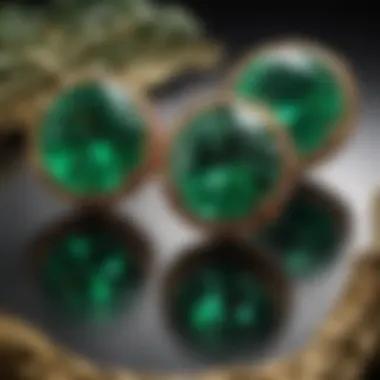
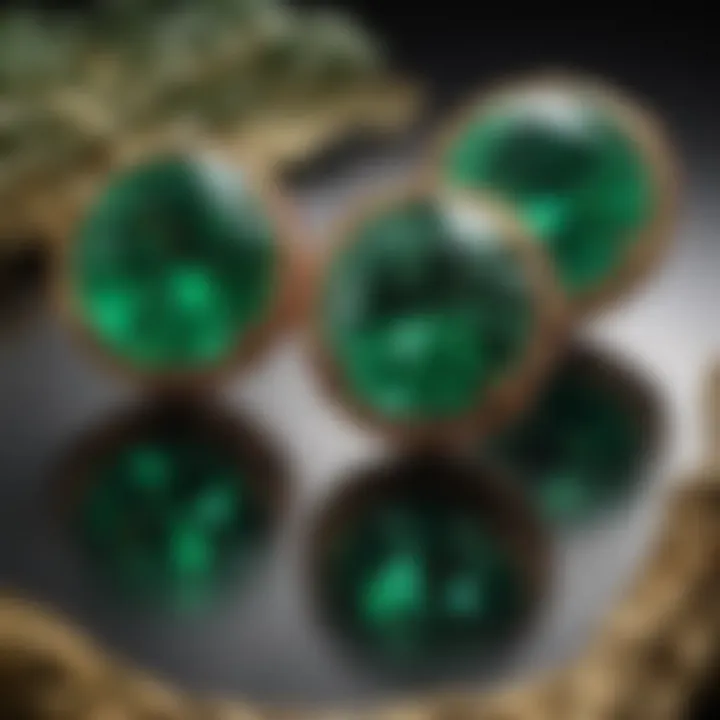
Green rubies present a notable investment potential due to their rarity and unique characteristics. Here are some considerations regarding investment:
- Long-Term Value: Historically, well-maintained gemstones have appreciated in value over time. As green rubies become more sought after, their potential for value increase looks promising.
- Market Diversification: Including unique gemstones like green rubies in an investment portfolio can enhance diversification, appealing to those looking to mitigate risks inherent in traditional investments.
- Collector Demand: The growing trend of gemstone collecting drives up demand, further solidifying their status as collectible items. Investors may find that connecting with jewelry designers can yield considerable returns as trends shift.
In summary, the economic implications of green rubies warrant careful consideration. As the market evolves and awareness of their unique properties increases, both pricing trends and investment potential continue to change, making these gemstones increasingly relevant in economic discussions.
Applications in Jewelry
The application of green rubies in jewelry represents a significant interaction between natural beauty and human creativity. These gemstones, though not as widely recognized as their red counterparts, carry unique aesthetics and value that appeal to both consumers and designers. The incorporation of green rubies into jewelry pieces offers not just a visually stunning element, but also a story and rich symbolism. Understanding their role in jewelry can provide insights into their overall significance and desirability in the market.
Design Considerations
When designing jewelry that features green rubies, various considerations come into play.
- Color Harmony: Green rubies display a vibrant hue that can complement a range of materials and stones. They work beautifully with gold or silver settings, but pairing them with other gemstones, such as sapphires or diamonds, is also popular. The contrast in colors can create striking visual results.
- Cut and Carat Size: The cut of a green ruby can influence its brilliance and appearance. Popular cuts, like cushion or oval, tend to enhance the gemstone's color depth. Larger stones can serve as stunning centerpieces, while smaller stones can be used effectively in intricate designs, such as pendants or earrings.
- Target Audience: Designers must consider who will wear the piece. A younger audience might prefer more contemporary designs, while older consumers might lean towards classic styles. Meeting the preferences of the target demographic can enhance marketability.
Versatility in Styles
Green rubies exhibit remarkable versatility, allowing them to fit into a wide array of jewelry styles. This adaptability significantly extends their usability in the marketplace.
- Contemporary Trends: Modern jewelry often embraces unique cuts and settings. Green rubies can be incorporated into minimalist designs where their color and shine can stand out attractively. Lightweight and understated settings can make these stones a popular choice for everyday wear.
- Classic Aesthetics: Traditional attire often finds a place for green rubies. Their royal hue and rarity can enhance vintage-inspired designs, such as art deco or Victorian styles, for those seeking elegance.
- Customizable Options: Green rubies are increasingly featured in custom jewelry designs. Engagement rings and anniversary pieces are opportunities to showcase the individuality of relationships. Couples can select the stone to symbolize unique aspects of their journey.
In summary, the versatility in styles makes green rubies a favorable choice for many consumers. Their ability to blend into various designs while maintaining their unique attributes ensures their relevance in the jewelry market.
Notable Green Ruby Jewelry Pieces
Green rubies hold a distinct position in the realm of gemstones, and notable green ruby jewelry pieces reflect their uniqueness and value. These items are much more than mere adornments; they tell stories of craftsmanship, history, and cultural significance. Understanding these pieces can provide insight into trends, styles, and the evolving appreciation for green rubies in jewelry design.
Historical Prestige
Historically, green rubies have been used in significant jewelry pieces that often symbolize wealth and status. Their rarity has made them highly sought after by nobility and collectors alike. One such piece is the famed "Emerald and Green Ruby Tiara" worn by royal families, showcasing intricate designs and luxurious stones. This tiara stands not just as a decorative headpiece but as a testament to the discerning tastes of its wearers.
Green rubies were often used in royal regalia, crafted into necklaces and brooches that highlighted their rich color and brilliance. The juxtaposition of green rubies with diamonds and gold has led to pieces that resonate with opulence. Collectors value these historical pieces highly due to their connection to prominent figures and events.
Modern Innovations
The allure of green rubies continues to inspire contemporary jewelry designers, who blend traditional techniques with modern aesthetics. Designers experiment with various styles, integrating green rubies into minimalist settings that enhance their natural beauty. They often use ethical sourcing and creative designs to appeal to a growing audience that values sustainability.
Innovative pieces, such as asymmetrical earrings or stacked rings featuring green rubies, are becoming more popular. These pieces are not just eye-catching but also versatile, allowing wearers to transition from daytime to evening wear easily. Additionally, many designers now create custom pieces, tailoring designs specifically to the individual preferences of clients, further elevating the significance of green rubies in modern fashion.
The rise of technology in jewelry design, such as 3D printing, has also allowed for more inventive styles and settings for green rubies. Jewels can now be crafted with precise detail, making the design process faster and more accessible to a broader audience. As such, green rubies continue to find themselves at the forefront of modern jewelry trends, reflecting advancements in both materials and design philosophies.
Notable green ruby pieces are not just adornments; they are symbols of cultural heritage and a testament to evolving artistic expression.
Future Trends in the Gem Market
The gemstone market, particularly for green rubies, is evolving. Understanding the future trends is crucial for gemstone enthusiasts and investors alike. Trends influence prices, design choices, and consumer preferences. The insights presented here will help buyers and collectors navigate this dynamic landscape.
Emerging Markets
Emerging markets are reshaping the demand for gemstones. Countries such as India, China, and some African nations are witnessing significant growth in their middle class. This demographic shift is increasing the market size for luxury items like green rubies.
Key factors include:
- Growing Wealth: As disposable income rises, more people are seeking luxury goods.
- Cultural Significance: In many cultures, gemstones hold a deep meaning, further driving demand.
- Online Marketplaces: The growth of e-commerce facilitates access to buyers in these markets. The convenience of online shopping allows gem enthusiasts to explore and purchase stones with ease.
This influx has the potential to stabilize prices and even increase the rarity of green rubies, making them more attractive to collectors.
Sustainability and Ethical Sourcing
The importance of sustainability in the gem market is increasingly apparent. Consumers are becoming more aware of the ethical implications of their purchases. Sustainability not only encompasses environmental factors but also social considerations. Here are notable aspects:
- Responsible Mining Practices: Companies are now adopting methods that minimize environmental impact. This approach often leads to cleaner extraction processes and reduced damage to ecosystems.
- Fair Labor Practices: Ensuring that workers in the gem mining sectors are treated fairly is gaining traction. Many consumers now expect transparency regarding labor practices.
- Certification Systems: Systems that certify gemstones' origins can enhance consumer trust. These systems provide assurance that the stones were sourced ethically, which can be particularly important for luxury items like green rubies.
"Sustainable practices are not just a trend; they are becoming fundamental for the future of the gemstone industry."
By focusing on sustainability, the gem market can enhance its credibility and appeal among the discerning buyers. Engagement with these practices boosts a brand's reputation and helps to reshape consumer behavior in a more ethical direction.
In summary, recognizing the future trends in the gem market, including the rise of emerging markets and the emphasis on sustainability, is essential. These trends will undoubtedly influence how green rubies and other gemstones are perceived, valued, and utilized in the years to come.
Closure
The conclusion of this article on green rubies brings to light the significant facets surrounding these exceptional stones. Understanding the characteristics and complexities of green rubies is not merely academic; it offers real-world benefits to collectors, jewelers, and enthusiasts alike.
Summation of Insights
In summary, the journey through the various sections has illustrated the multifaceted nature of green rubies. From their rare formation conditions to their unique optical properties, the insights gained in this analysis highlight not only their beauty but also their value in the gem market. Green rubies deserve distinct recognition when compared against their traditional red counterparts and other green gemstones. The discussion surrounding authenticity and market trends adds substantial depth to our understanding. Consequently, a collector or buyer can recognize the importance of assessing these stones with informed scrutiny.
Final Thoughts on Green Rubies
It is essential for gemstone admirers to approach green rubies with a well-informed mindset, understanding both their value and care, ensuring they remain a cherished part of jewelry history.



